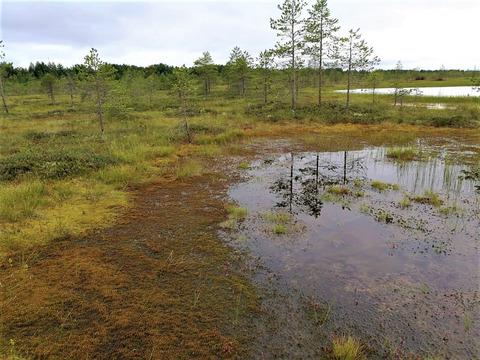Our official English website, www.x-mol.net, welcomes your feedback! (Note: you will need to create a separate account there.)
Functional diversity and trait composition of vascular plant and Sphagnum moss communities during peatland succession across land uplift regions
Journal of Ecology ( IF 5.5 ) Pub Date : 2021-01-28 , DOI: 10.1111/1365-2745.13601 Anna M. Laine 1, 2 , Tapio Lindholm 3 , Mats Nilsson 4 , Oleg Kutznetsov 5 , Vincent E. J. Jassey 6 , Eeva‐Stiina Tuittila 2
中文翻译:

陆地隆升区泥炭地演替过程中维管植物和泥炭藓群落的功能多样性和性状组成
更新日期:2021-04-08
Journal of Ecology ( IF 5.5 ) Pub Date : 2021-01-28 , DOI: 10.1111/1365-2745.13601 Anna M. Laine 1, 2 , Tapio Lindholm 3 , Mats Nilsson 4 , Oleg Kutznetsov 5 , Vincent E. J. Jassey 6 , Eeva‐Stiina Tuittila 2
Affiliation

|
- Most of the carbon accumulated into peatlands is derived from Sphagnum mosses. During peatland development, the relative share of vascular plants and Sphagnum mosses in the plant community changes, which impacts ecosystem functions. Little is known on the successional development of functional plant traits or functional diversity in peatlands, although this could be a key for understanding the mechanisms behind peatland resistance to climate change. Here we aim to assess how functionality of successive plant communities change along the autogenic peatland development and the associated environmental gradients, namely peat thickness and pH, and to determine whether trait trade‐offs during peatland succession are analogous between vascular plant and moss communities.
- We collected plant community and trait data on successional peatland gradients from post‐glacial rebound areas in coastal Finland, Sweden and Russia, altogether from 47 peatlands. This allowed us to analyse the changes in community‐weighted mean trait values and functional diversity (diversity of traits) during peatland development.
- Our results show comparative trait trade‐offs from acquisitive species to conservative species in both vascular plant and Sphagnum moss communities during peatland development. However, mosses had higher resistance to environmental change than vascular plant communities. This was seen in the larger proportion of intraspecific trait variation than species turnover in moss traits, while the proportions were opposite for vascular plants. Similarly, the functional diversity of Sphagnum communities increased during the peatland development, while the opposite occurred for vascular plants. Most of the measured traits showed a phylogenetic signal. More so, the species common to old successional stages, namely Ericacae and Sphagna from subgroup Acutifolia were detected as most similar to their phylogenetic neighbours.
- Synthesis. During peatland development, vegetation succession leads to the dominance of conservative plant species accustomed to high stress. At the same time, the autogenic succession and ecological engineering of Sphagna leads to higher functional diversity and intraspecific variability, which together indicate higher resistance towards environmental perturbations.
中文翻译:

陆地隆升区泥炭地演替过程中维管植物和泥炭藓群落的功能多样性和性状组成
- 积累到泥炭地中的大部分碳都来自泥炭藓。在泥炭地开发过程中,维管植物和泥炭藓在植物群落中的相对份额发生了变化,从而影响了生态系统的功能。关于泥炭地功能性植物性状或功能多样性的连续发展,鲜为人知,尽管这可能是了解泥炭地抵御气候变化背后机制的关键。在这里,我们旨在评估连续植物群落的功能如何随着自生泥炭地的发展以及相关的环境梯度(即泥炭厚度和pH)的变化,并确定在泥炭地演替过程中性状的权衡是否与维管植物群落和苔藓群落相似。
- 我们从芬兰沿海,芬兰和瑞典以及俄罗斯的冰川后反弹地区(共47个泥炭地)收集了有关连续泥炭地梯度的植物群落和性状数据。这使我们能够分析泥炭地开发过程中社区加权平均特征值和功能多样性(特征多样性)的变化。
- 我们的研究结果表明,在泥炭地开发过程中,维管植物和泥炭藓藓群落中从习性物种到保守物种的比较性状权衡。但是,苔藓比维管植物群落对环境变化的抵抗力更高。在种内性状变异比苔藓性状的物种更新更大的比例中可以看到这一点,而维管植物的比例则相反。同样,泥炭藓的功能多样性在泥炭地开发过程中,群落增加,而维管植物则相反。大多数测得的性状表现出系统发育信号。更重要的是,发现了旧演替阶段共有的物种,即来自Acutifolia亚类的Ericacae和Sphagna,与它们的系统发育邻居最为相似。
- 综合。在泥炭地开发过程中,植被演替导致习惯于高胁迫的保守植物物种占主导地位。同时,Sphagna的自生演替和生态工程导致更高的功能多样性和种内变异性,共同表明对环境扰动的抵抗力更高。

























 京公网安备 11010802027423号
京公网安备 11010802027423号